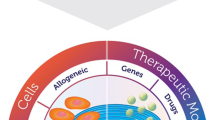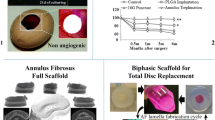Abstract.
The intervertebral disc unites the vertebrae in the spine, providing the flexibility required for bending and twisting and resisting the compression inflicted by gravity when in an upright posture. The discs have a complex structure, with the outer annulus fibrosus having lamellae of organized collagen fibrils and the inner nucleus pulposus having a more random collagen organization and an abundance of aggregating proteoglycans. This composite nature endows the disc with both the tension-resisting properties of a ligament and the compression-resisting properties of articular cartilage. Unfortunately, disc structure and function does not remain optimal throughout life, but undergoes progressive degeneration, commencing in the young adult, and is particularly evident in the nucleus pulposus. With time, disc degeneration may result in clinical symptoms, such as low back pain, and require medical intervention. Such treatment may involve removal of the offending disc by surgery rather than its repair, which would be the preferred course of action. In the near future, current bioengineering techniques may offer the possibility of repairing the damaged disc, if an engineered tissue with the appropriate functional properties can be generated to augment the ailing disc. In this report, we summarized our recent results, in which disc cells were implanted into a scaffold of collagen and hyaluronan, or entrapped into a chitosan gel, and growth factors were used to modulate matrix synthesis in an attempt to produce a tissue with a similar molecular composition to native nucleus pulposus tissue.
Similar content being viewed by others
Author information
Authors and Affiliations
Additional information
Electronic Publication
Rights and permissions
About this article
Cite this article
Alini, .M., Roughley, .P., Antoniou, .J. et al. A biological approach to treating disc degeneration: not for today, but maybe for tomorrow. Eur Spine J 11 (Suppl 2), S215–S220 (2002). https://doi.org/10.1007/s00586-002-0485-8
Received:
Accepted:
Issue Date:
DOI: https://doi.org/10.1007/s00586-002-0485-8




